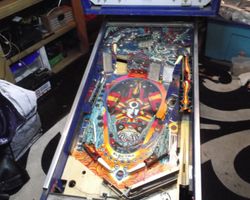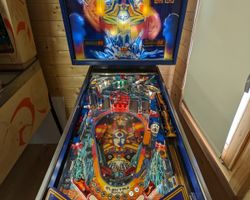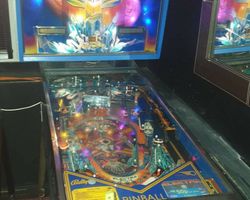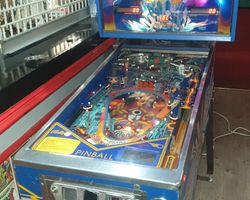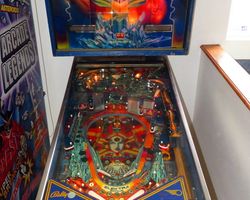Elektra
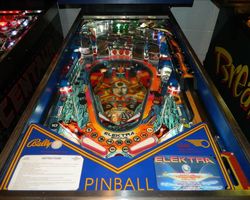
Average Prices: USD $300 to $1,900
Produced: December, 1981
Production Run: 2,950 units
Machine Type: Solid State Electronic
MPU: Bally MPU AS-2518-35
Players: 4
Design by: Claude Fernandez
Art by: Tony Ramunni
The pinball machine "Elektra," released by Bally Manufacturing Corporation in December 1981, represented a significant moment in solid-state pinball design. Priced at an MSRP of $1200 upon its debut, this machine was ambitious, aiming to deliver a unique play experience unlike anything before it. The visionary design for Elektra was conceived by Claude Fernandez, with the distinct artwork brought to life by Tony Ramunni. Rehman Merchant was responsible for the software development, weaving the complex ruleset into the machine's electronic brain. With a production run of 2,950 units, Elektra was not as widely distributed as some of its contemporaries, making it a relatively uncommon sight on location.
The machine's theme drew heavily from fantasy and science fiction, centered around a powerful, futuristic female figure. This "Elektra Girl" motif dominated the visual identity, particularly on the backglass. An interesting anecdote surrounds the backglass art: an early version depicted the Elektra Girl with an expression deemed too stern and with visible anatomical outlines, prompting Bally executives to commission a redraw. A small number of these original backglasses were produced before the more common, revised version entered circulation. This detail highlights the meticulous attention, or perhaps last-minute adjustments, that went into the machine's presentation. Further adding to the machine's unique history, some 'Elektra' cabinets were reportedly repurposed and overpainted for Bally's subsequent game, 'Vector', suggesting a potential adjustment in production quantities to accelerate the release of the next title.
Signature Features and Design
Elektra's primary signature feature, heavily advertised with the slogan "A Three Level Electrifying Experience," was its pioneering three-level playfield. This was the first solid-state pinball machine to incorporate such a complex, multi-tiered design, a bold move for its era. The main playfield itself was covered by a sheet of Plexiglas, contributing to a smooth ball flow and lending the machine a distinctly futuristic aesthetic. This choice of material was innovative, setting it apart from standard playfield surfaces.
Beyond the multi-level architecture, Elektra incorporated custom speech, an advanced feature for 1981, adding an immersive auditory layer to the gameplay experience. The backbox design also contributed to the machine's unique appeal, featuring four sets of dual lights that rotated within a "cloud" during attract mode and normal play. When the ball entered the lower playfield, these lights transformed, chasing from the Elektra diamond up into the main Elektra logo, dynamically reflecting the player's progression. The absence of traditional pop bumpers, a staple in most pinball designs, was a deliberate choice that shaped Elektra's gameplay, promoting a different pace and requiring alternative shot strategies. The overall artwork, with its vibrant colors and futuristic, artistic style, provided a cohesive visual identity that contributed to its "cool 80s" vibe.
Playfield and Mechanics
The playfield of Elektra is a complex arrangement, designed to challenge players across its three distinct levels. The primary playfield is extensive, guiding players through an intricate network of shots. It features two kick-out holes and two rollunder spinners, which are central to building score and advancing objectives. A single captive ball provides another interactive element, requiring precise shots to strike and collect points. Two in-line drop targets guard access to certain areas, demanding accuracy from players. Four ramps punctuate the layout, offering varied shot opportunities; however, one ramp, particularly the second from the right, gained a reputation as a "drain monster" due to its propensity for sending the ball directly out of play.
The design philosophy behind Elektra's layout leaned towards precision and deliberate play. The absence of pop bumpers meant that chaos was minimized, and success hinged more on controlled shots and understanding the machine's intricate ruleset. The most compelling aspect of the playfield is its interaction with the lower and upper levels. The upper playfield, while an integral part of the three-level design, is notably compact, sometimes leading to short ball times or making it difficult to execute shots effectively. The lower playfield is the true spectacle: it is not merely an extension, but a separate, self-contained area accessed only by accumulating "Elektra Units" on the main playfield and then draining the current ball. This unique mechanism involves a fourth, distinct ball that is exclusively used on this hidden, lower level, creating a feeling of discovery and significant accomplishment when accessed. The interplay of artwork, lighting, and sound across these levels contributes to an enveloping aesthetic that complements the machine’s futuristic theme.
Gameplay Dynamics
Elektra’s gameplay dynamics are characterized by their depth and a deliberate pacing, distinguishing it from the rapid-fire action of many of its contemporaries. The core progression revolves around accumulating "Elektra Units," which are crucial for unlocking access to the machine's lower playfield. This mechanism forces players to engage strategically with the main playfield's targets and shots before they can descend into the hidden area. Once enough units are gathered, draining the current ball sends the next ball into the lower playfield, transforming the game experience with a completely different layout and set of targets. This transition adds a layer of objective-based play that was innovative for its time, moving beyond simple high-score chasing.
The scoring system, while complex, rewards players who master the machine's intricate shot sequences. Multiball, a highly sought-after feature, is present as a two-ball mode but is widely regarded as exceptionally difficult to achieve, often requiring a precise and challenging series of shots. This difficulty enhances the reward for players who manage to trigger it. Unique objectives include activating various features to earn "Elektra Units," navigating the challenging upper playfield, and making the most of limited ball time on the lower level. The custom speech, with its "electrifying" or "hypnotic" electronic background hum, creates an immersive atmosphere, though some found the attract mode’s repeated calls to be repetitive. Player strategies often involve prioritizing specific targets to earn units, mastering the four ramps, and developing the precision needed to control the ball's flow on all three levels. The game's deliberate pace and emphasis on strategic shot placement over chaotic ricochets make for a cerebral challenge that appeals to players who enjoy mastering a deep ruleset.
Reception and Legacy
Elektra's reception within the pinball community has been notably mixed, yet it consistently holds a position as a machine that elicits strong opinions. Many enthusiasts regard it as a "sleeper classic," an "underrated" title, or even "ahead of its time," particularly in recognition of its groundbreaking triple-level playfield. This innovative design is almost universally praised as the machine’s defining strength, a concept that captivated players and hinted at future possibilities for pinball layouts. The machine’s futuristic theme, artistic backglass, and unique color palette also frequently receive commendation for their visual appeal, embodying a distinctive 1980s aesthetic. For those willing to invest the time, Elektra’s ruleset is often described as deep and challenging, offering a rewarding experience for skilled players. The distinctive electronic hum and voiceovers contribute to an atmospheric experience, drawing players further into its world. Furthermore, its relative rarity and unique features contribute to its appeal as a collector’s item.
However, Elektra also faces significant criticism. A common sentiment is that the gameplay can be slow and, for some, even boring, particularly when compared to machines with more active pop bumper action, which Elektra intentionally lacks. The complexity that some find rewarding, others perceive as an overwhelming set of rules that are difficult to discern without external guidance. The upper playfield, while part of the innovative design, is frequently criticized for being small, leading to short ball times and challenging, sometimes frustrating, shot angles. Serviceability is another point of contention, with the under-playfield wiring often described as a "rat’s nest." Some players also noted weak slingshots or less intuitive flipper action, and specific ramps were known to be "drain monsters," leading to quick losses. Unfavorable comparisons to other Bally titles of the era, such as 'Flash Gordon', sometimes position Elektra as the less engaging experience.
Despite these criticisms, Elektra's legacy as the first solid-state pinball machine with a three-level playfield remains unassailable. It proved that such ambitious, multi-tiered designs were feasible, paving the way for more complex layouts in subsequent decades. While it may not have achieved universal adoration, Elektra stands as a testament to Bally's willingness to innovate and push the boundaries of pinball design, securing its place as an important, if often debated, chapter in pinball history.
Sponsored Links
 Ebay Listings
Ebay Listings
 Auction Results
Auction Results
| Cost | Location | Date |
|---|---|---|
| USD $1,600 |  Michigan, United States Michigan, United States |
23 October, 2025 |
| GBP £3,067 |  United Kingdom United Kingdom |
03 June, 2025 |
| GBP £1,843 |  Chelmsford, United Kingdom Chelmsford, United Kingdom |
20 April, 2025 |
| USD $2,750 |  Michigan, United States Michigan, United States |
02 January, 2025 |
| EUR €1,471 |  Nordrhein-Westfalen, Germany Nordrhein-Westfalen, Germany |
21 July, 2024 |
| USD $3,800 |  Missouri, United States Missouri, United States |
07 April, 2024 |
| USD $2,999 |  Florida, United States Florida, United States |
16 February, 2024 |
| USD $2,495 |  California, United States California, United States |
19 July, 2023 |
| USD $2,500 |  Michigan, United States Michigan, United States |
15 April, 2023 |
| GBP £1,995 |  Nuneaton, United Kingdom Nuneaton, United Kingdom |
03 April, 2023 |


Private Policy · Search Website · Contact Us
As an eBay Partner, we may earn a commission from qualifying purchases made through links on this site, at no additional cost to you.
All trademarks and copyrighted materials remain property of their respective owners. All other content copyright 2007 - 2026 Pinpedia.

